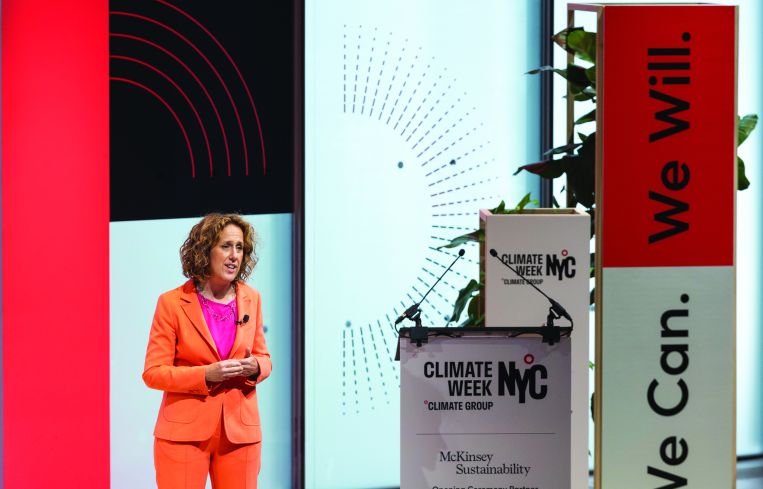Climate Week NYC This Year Was More About Action Than Talk
Various conferences and demonstrations showcased commercial real estate’s expanding role in reducing carbon emissions
By Abigail Nehring September 22, 2023 4:07 pm
reprints
It began with a demonstration. Tens of thousands of people marched through Midtown Manhattan on Sunday, Sept. 17, calling on world leaders to usher in the end of fossil fuels ahead of the United Nations’ Climate Ambition Summit.
The opening ceremony of Climate Week NYC took place simultaneously across town, kicking off a singularly industrious and gridlocked week in New York City. The official Climate Week calendar contained more than 400 events this year — and, for the uninitiated, there is now a 2-year-old free mobile app that helps participants browse the offerings and design a personal schedule.
It feels like this is the “year of contradictions,” said Helen Clarkson, CEO of the nonprofit Climate Group, in her opening address at the Times Center at 242 West 41st Street. “We’re living through a solar boom, but this year Canada’s forests were reduced to ashes, forcing people right here in New York to stay indoors.
“So yes, we can,” she said. “—but will we?”
When it comes to reducing carbon emissions from commercial buildings — a key component to any mass environmental effort — 2023 marks a pivot from goal-setting to implementation. It’s what Clarkson called the “messy middle” of the energy transition.
Advances in data collection and the consolidation of reporting standards are making it easier for property managers to jump on the net-zero bandwagon. But value creation remains a prerequisite for investors and financial services providers to make sustainability a part of their investment strategy.
A survey of 300 real estate companies conducted this year by British bank HSBC revealed that lenders remain the gatekeepers of climate innovation to a surprising degree. Forty percent of respondents said that access to finance is the No. 1 barrier to improving their real estate portfolio’s sustainability.
And, in the office sector, demand for space in low-carbon buildings is on track to outstrip supply by 75 percent across all major markets in the United States by 2030, JLL researchers found in a report released during Climate Week.
The new premium for sustainable office leases has begun to rear its head in London and Paris, Guy Grainger, JLL’s global head of sustainability services and ESG, noted in an analysis of the findings.
Corporate tenants have the most to gain, Grainger wrote, because they know “leasing low-carbon spaces and decarbonizing their real estate operations are easier wins compared to tackling Scope 3 emissions across their supply chains.”
Industrial owner Prologis blazed a new path in 2018 when it proffered its letter of commitment to the Science Based Targets initiative, a nonprofit advisory group that validates private sector emissions reduction targets using standards set by the 2015 Paris Agreement. In doing so, Prologis became the largest industrial real estate investment trust to set a specific emissions target.
Prologis updated that target last year, setting a net-zero goal across Scope 1, 2 and 3 emissions by 2040. The emissions accounting categories cover all sources produced by a company directly, indirectly, and as a result of all of the assets it owns.
“Now this is when all the work starts,” said Suzanne Fallender, vice president of ESG at Prologis, who was a panelist at JLL’s “Finance, Real Estate & Sustainability” event at 320 Park Avenue on Monday. “It touches every part of the company.”
She said the company’s current focus is building solar capacity sufficient to generate 1 gigawatt of electricity by 2025. That means putting a solar-ready roof and electric vehicle hookups on every new development.
“Our investment strategy is that sustainability and climate risk can be material to the financial performance of real estate,” said LaSalle Investment Management’s sustainability head Elena Alschuler, also a panelist at the JLL event.
At panels and networking events across the city, commercial real estate’s sustainability leaders showed little reticence about getting into the nitty-gritty of the Inflation Reduction Act and other public funding opportunities at the state and local level.
One of the first projects selected to participate in the Empire Building Challenge’s low-carbon public-private design partnership is underway at 345 Hudson in Hudson Square: a 1931 commercial office building adjacent to Hines’ state-of-the-art carbon-neutral office tower at 555 Greenwich. Serpentine tubes run through the building’s floor slabs and transfer warmth from deep underground using technology developed in Norway and Sweden.
A $5 million investment from the New York State Energy Research and Development Authority (NYSERDA) will go toward developing a hydronic loop between the two properties and ultimately ween the older building off fossil fuel heating.
Getting tenants and landlords to align their goals is still the perennial challenge. It’s been one of Michael Reed’s chief preoccupations during his six years as NYSERDA’s head of advanced energy solutions.
“There’s nothing new under the sun,” Reed said at a panel hosted by Hines in a sun-drenched cement amphitheater on the ground floor of 555 Greenwich on Wednesday. “The split incentive has existed for a very long time. What’s changing is the imperative.”
The next day, Gov. Kathy Hochul announced New York will commit to quadrupling heat pump installations by 2030 on behalf of the U.S. Climate Alliance, a coalition of 25 governors targeting 20 million heat pump installations across the United States in the same time frame.
“I’m not sure that we’re at the point where you can sort of use a program or come up with a menu of items to get you to where you need to go,” said Ben Rodney, Hines’ vice president of construction in the east region. “For owners that don’t have the same access to capital, having software to come up with solutions at a lower price point and faster, I think, is going to be extremely critical.
“It’ll be interesting to see which sort of companies become the winners in this space in the coming years.”
Abigail Nehring can be reached at anehring@commercialobserver.com.


